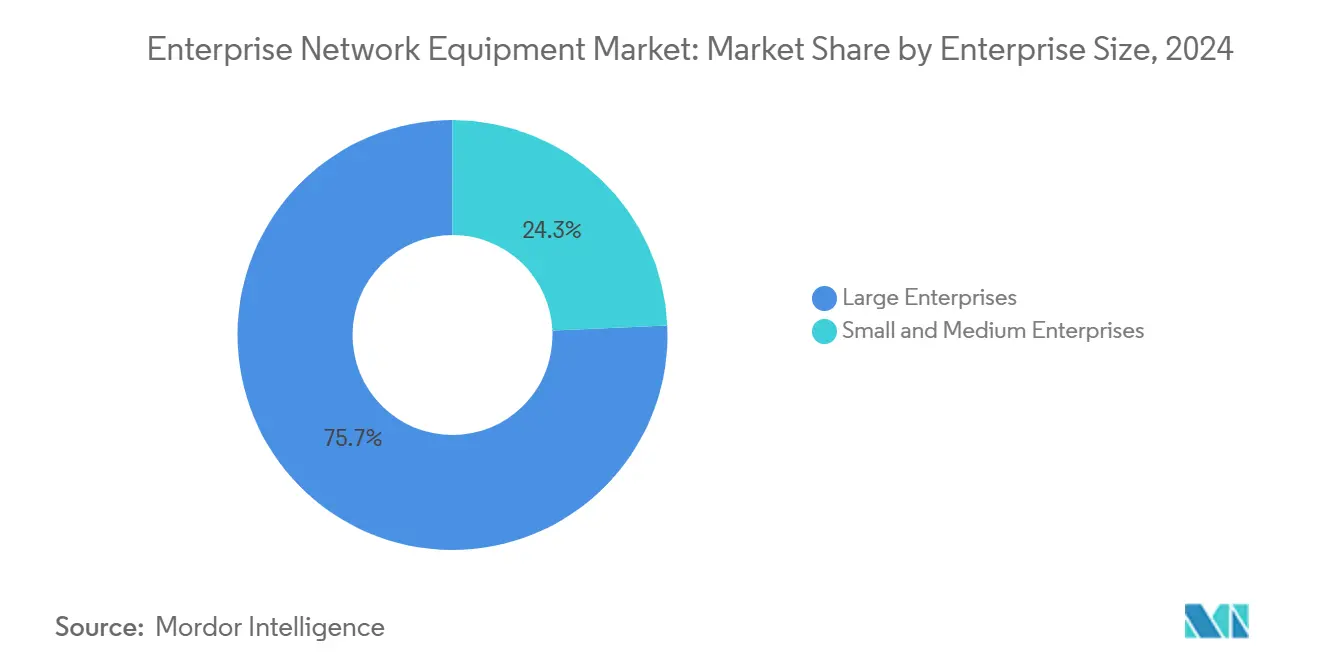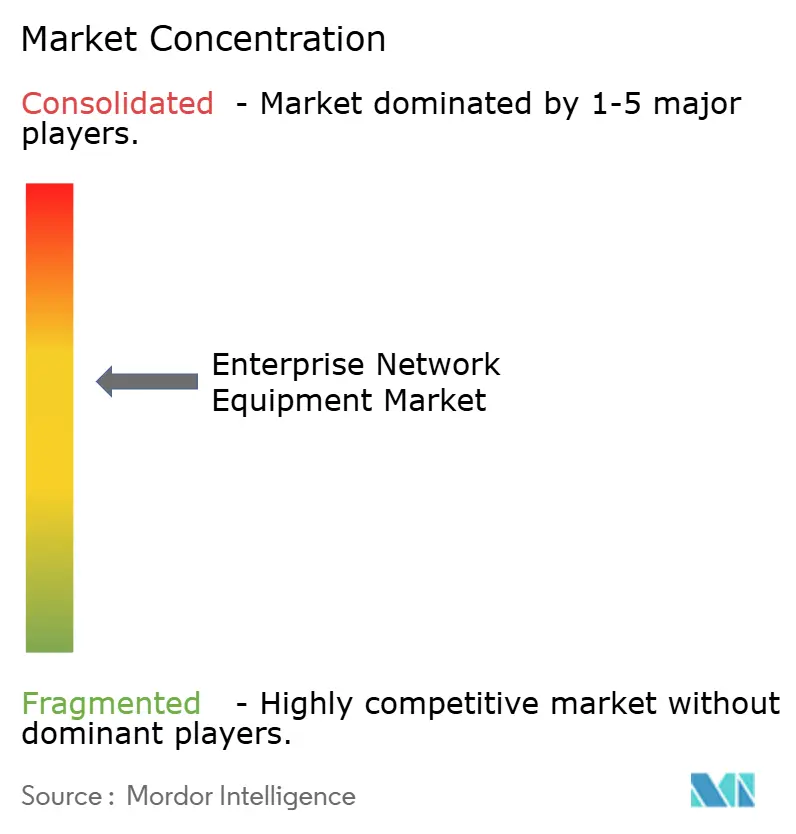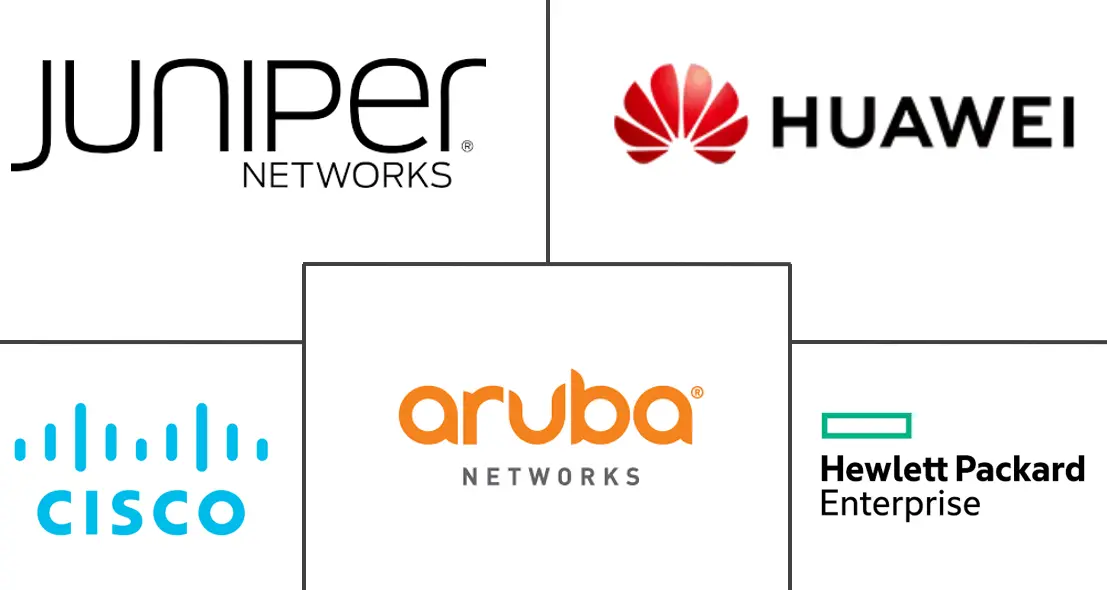Enterprise Network Equipment Market Size and Share

Enterprise Network Equipment Market Analysis by Mordor Intelligence
The enterprise network equipment market was valued at USD 83.51 billion in 2025 and is projected to reach USD 147.30 billion by 2030, advancing at a 12.02% CAGR across the forecast window. This expansion stems from enterprise migration toward AI-optimized, cloud-managed infrastructure that favors software-defined control, bandwidth scalability, and automated operations over legacy hardware dependence. Strong demand for 400 G and 800 G switching inside data centers, urgent Wi-Fi 7 upgrades on campus networks, and rising SD-WAN roll-outs in branch sites all reinforce spending momentum. Supply-chain constraints for high-speed optical transceivers tighten inventory, giving vertically integrated vendors a pricing edge. In parallel, sustainability programs push low-power silicon that cuts the total cost of ownership by 15-20% during five-year cycles. Industry consolidation accelerates as platform vendors merge switching, security, and AI analytics into unified stacks.
Key Report Takeaways
- By type, switches held 41.7% of the enterprise network equipment market share in 2024, whereas wireless LAN is advancing at a 13.8% CAGR through 2030.
- By deployment model, on-premises accounted for 51.8% of the enterprise network equipment market size in 2024, but cloud-managed solutions are forecast to expand at a 13.7% CAGR to 2030.
- By enterprise size, large enterprises captured 75.7% revenue share of the enterprise network equipment market in 2024, while SMEs are recording the highest CAGR at 13.0% through 2030.
- By end-user vertical, IT and Telecom held 29.8% of the 2024 revenue of the enterprise network equipment market; healthcare is slated to grow at a 14.0% CAGR between 2025 and 2030.
- By geography, North America dominated with 38.21% revenue of the enterprise network equipment market in 2024, whereas Asia-Pacific is projected to climb at a 13.9% CAGR during the period.
Global Enterprise Network Equipment Market Trends and Insights
Drivers Impact Analysis
| Driver | (~) % Impact on CAGR Forecast | Geographic Relevance | Impact Timeline |
|---|---|---|---|
| Surging bandwidth demand from IoT and edge computing | +2.5% | Global, Asia-Pacific leading | Medium term (2-4 years) |
| Rapid enterprise-wide upgrades to Wi-Fi 7 campus LANs | +1.8% | North America, Europe core | Short term (≤2 years) |
| Cloud-managed networking and SD-WAN adoption | +1.2% | Global, strong in SMEs | Medium term (2-4 years) |
| Government-backed smart-city backbone roll-outs | +0.9% | Asia-Pacific and MEA | Long term (≥4 years) |
| AI-driven need for 400/800 G switches in data centers | +0.7% | North America, EU | Short term (≤2 years) |
| Sustainability mandates pushing low-power silicon | +0.6% | EU leadership, global adoption | Long term (≥4 years) |
| Source: Mordor Intelligence | |||
Surging Bandwidth Demand from IoT and Edge Computing
Edge architectures move processing close to data sources, multiplying traffic loads that older campus networks cannot support. Industrial IoT sites stream terabytes of sensor information that require 25 G or 100 G uplinks without latency penalties.[1]Cisco Systems, “Q1 2025 Financial Results,” investor.cisco.com Cisco’s 2025 results showed 34% revenue growth in edge networking, fueled by manufacturing and logistics predictive-maintenance projects. Converged private 5G and Wi-Fi domains add hybrid device density, while computer-vision workloads consume 10-15 times traditional bandwidth, forcing east-west traffic design over north-south flows.
Rapid Enterprise-Wide Upgrades to Wi-Fi 7 Campus LANs
Wi-Fi 7 accelerates refresh cycles because wireless speed now drives productivity metrics. The IEEE 802.11be spec reaches 46 Gbps using 320 MHz channels, letting firms replace wired desktops with reliable wireless links.[2]IEEE Standards Association, “IEEE 802.11be Ratification,” ieee.org Arista recorded 27.6% campus switching growth in Q1 2025, with 60% tied to Wi-Fi 7 backhaul and PoE upgrades. High-density venues such as conference areas benefit from deterministic latency that supports AR in manufacturing and medical training.
Cloud-Managed Networking and SD-WAN Adoption
Software-defined management shifts operations from device-level CLI to centralized policy engines. SMEs adopt cloud control at a 13.0% CAGR because it removes expertise barriers while delivering security and analytics. VMware’s SD-WAN revenue gained 23% in 2024, with 70% of wins displacing MPLS via intelligent traffic steering. Consumption pricing aligns costs to seasonal demand, and machine-learning engines adjust quality of service, bandwidth, and segmentation in real time.
Government-Backed Smart-City Backbone Roll-Outs
Municipal programs in APAC and MEA integrate IoT sensors, surveillance, and public Wi-Fi into unified fiber and wireless backbones. Contracts stipulate open standards for multi-vendor interoperability and favor low-power PoE street furniture. Long-term projects sustain demand for ruggedized switches, secure edge routers, and high-bandwidth aggregation links that connect city data lakes to analytics cores.
Restraints Impact Analysis
| Restraint | (~) % Impact on CAGR Forecast | Geographic Relevance | Impact Timeline |
|---|---|---|---|
| High maintenance and compliance-driven security costs | -1.4% | Global, EU and US | Medium term (2-4 years) |
| Ongoing semiconductor supply-chain constraints | -0.8% | Global, Asia-Pacific manufacturing | Short term (≤2 years) |
| Shortage of skilled engineers for SDN | -0.6% | North America, EU, rising Asia-Pacific | Long term (≥4 years) |
| Pandemic-era inventory overhang delaying refresh | -0.5% | Global | Short term (≤2 years) |
| Source: Mordor Intelligence | |||
High Maintenance and Compliance-Driven Security Costs
HIPAA, PCI DSS 4.0, and emerging AI laws force continuous monitoring, segmentation, and audit logging that raise operating expenses 20–30% of IT budgets.[3]U.S. Department of Health and Human Services, “HIPAA Security Rule Updates,” hhs.gov Financial firms deploy zero-trust overlays that need specialized appliances and expert services, lifting lifecycle costs above initial hardware spend.
Ongoing Semiconductor Supply-Chain Constraints
AI-optimized switch chips and optical modules face chronic shortages. Lead times stretch to a year, hindering roll-outs and favoring vendors with captive fabs. VIAVI’s USD 3.7 billion Spirent buyout sought to consolidate test capacity, but bottlenecks remain. Enterprises extend asset lifecycles and qualify secondary suppliers, increasing architectural complexity.
Segment Analysis
By Type: Switching Holds Share, WLAN Leads Growth
Switches captured 41.7% of the enterprise network equipment market in 2024, underscoring their centrality in campus and data-center topologies. The enterprise network equipment market size for switches is projected to rise with AI workloads that demand 400 G and 800 G fabrics offering line-rate, non-blocking performance. Wireless LAN remains the fastest mover at a 13.8% CAGR as Wi-Fi 7 enables high-density, low-latency mobility inside office, healthcare, and education environments. Routers maintain relevance in SD-WAN, while network-security appliances gain traction through micro-segmentation and behavior analytics.
Campus modernizations merge PoE upgrades with new multi-gigabit cabling to support power-hungry Wi-Fi 7 access points. Access controllers adopt cloud dashboards that automate channel assignment and threat mitigation. Edge switches integrate time-sensitive networking to carry industrial IoT traffic. Vendors enhance ASIC telemetry to give IT teams visibility down to buffer utilization, a capability vital for AI inference jitter control.

Note: Segment shares of all individual segments available upon report purchase
By Deployment Model: Cloud-Managed Momentum
On-premises installations delivered 51.8% revenue in 2024, driven by data sovereignty rules among finance and government buyers. Still, cloud-managed adoption outpaces at 13.7% CAGR as organizations favor opex subscriptions and rapid rollout. The enterprise network equipment market share for cloud-managed platforms will widen as SMEs adopt plug-and-play Wi-Fi and SD-WAN solutions administered from multitenant portals.
Hybrid control gains fans in regulated industries that keep policy engines on-site while feeding analytics to the cloud. API-first design lets DevOps teams integrate network workflows into CI/CD pipelines. Consumption pricing smooths cash flows and lowers the barrier to branch expansion. Vendors differentiate through AI engines that predict faults and recommend remediation without manual ticketing.
By Enterprise Size: SMEs Accelerate through Simplification
Large enterprises owned 75.7% of 2024 spending as their global footprints require massive refresh programs. Yet SMEs drive the velocity at 13.0% CAGR thanks to turnkey cloud platforms that mask complexity. The enterprise network equipment market size for the SME cohort expands as vendors bundle security, Wi-Fi, and SD-WAN in affordable kits.
Big organizations deploy AI-driven analytics that forecast capacity and spot anomalies. They value vendor road-maps, lifecycle guarantees, and global supply chains. SMEs instead prize ease of installation, mobile-app management, and flexible term licensing. Both groups converge on zero-trust requirements, but implementation depth varies with risk tolerance and staffing.

By End-User Vertical: Healthcare Leads Growth
IT and Telecom drove 29.8% of 2024 demand because carriers upgrade core and edge to support private 5G. Healthcare now leads growth at 14.0% CAGR as new HIPAA security rules push micro-segmentation and continuous monitoring. The enterprise network equipment market size for healthcare expands when hospitals adopt Wi-Fi 7 for tele-surgery and AR training while segmenting patient IoT devices.
Manufacturing pursues deterministic networking for robotic and vision systems, demanding sub-millisecond latency and IEC 62443 security. BFSI implements PCI DSS 4.0-compliant zero-trust networks to protect cardholder data while enabling digital banking. Retail rebuilds wireless to power omnichannel checkout and immersive customer analytics. Government smart-city initiatives require rugged switches and secured edge devices, forming a sizeable long-term opportunity.
Geography Analysis
North America retained 38.21% of 2024 revenue, fueled by early uptake of AI-centric fabrics and large hyperscale data-center footprints. Financial and healthcare regulations encourage rapid modernization with zero-trust overlays and campus Wi-Fi 7 adoption. The enterprise network equipment market size in the region benefits from strong capital budgets and a robust partner ecosystem.
Asia-Pacific shows the highest 13.9% CAGR through 2030. Chinese private 5G liberalization and Japanese digitization under Society 5.0 boost orders for wireless and edge equipment. Local procurement guidelines in China favor domestic switching suppliers, reshaping vendor share. India’s cloud boom magnifies SME demand for cloud-managed SD-WAN and Wi-Fi.
Europe posts steady growth anchored in GDPR compliance, digital sovereignty, and green-tech directives. German Industry 4.0 programs drive deterministic Ethernet adoption, while Nordic sustainability rules reward low-power silicon. Middle East and Africa secure smart-city funding that installs fiber backbones and metro Wi-Fi, though macro volatility tempers spending. South America invests in 5G backhaul and municipal broadband, but currency fluctuations influence deal timing.

Competitive Landscape
Market structure sits in the mid-consolidated zone. Cisco continues to dominate through an end-to-end portfolio and established channels. HPE’s USD 14 billion Juniper takeover adds AI networking to its compute stack, intensifying North American platform rivalry.[4]Hewlett Packard Enterprise, “HPE Completes Acquisition of Juniper,” hpe.com Arista edges ahead in AI switching, enjoying 27.6% year-over-year campus revenue growth on Wi-Fi 7 integration.
Vendors pivot toward vertical integration that unites silicon, operating systems, security, and cloud management. Supply-chain resilience becomes a differentiator as shortages persist. Early Wi-Fi 7 certification creates a short-term edge for suppliers like TP-Link in the SME tier. White-box ODMs challenge incumbents in hyperscale but lack channel depth for enterprise penetration.
Software subscription and consumption billing shift revenue recognition away from perpetual licenses. Vendors embed AI operations that promise self-healing networks, lowering total cost and increasing stickiness. Partnerships, such as Extreme Networks with Microsoft Azure, underscore multicloud alignment. M&A continues as players acquire security analytics or test-equipment assets to cover solution gaps.
Enterprise Network Equipment Industry Leaders
-
Cisco Systems Inc.
-
Huawei Technologies Co. Ltd.
-
Hewlett Packard Enterprise Company
-
Aruba Networks LLC
-
Juniper Networks Inc.
- *Disclaimer: Major Players sorted in no particular order

Recent Industry Developments
- July 2025: Hewlett Packard Enterprise completed its USD 14 billion acquisition of Juniper Networks, forming a unified AI-enabled networking platform.
- June 2025: Arista Networks unveiled an 800 G switch with sub-microsecond latency tailored for AI clusters.
- May 2025: VIAVI Solutions finalized its USD 3.7 billion Spirent deal to consolidate network test capabilities.
- April 2025: Cisco pledged USD 1.2 billion to build autonomous network-management software.
- March 2025: Extreme Networks partnered with Microsoft Azure for integrated cloud-managed Wi-Fi 7 solutions.
- February 2025: Fortinet expanded SD-WAN through telecom alliances for secured global reach.
- January 2025: TP-Link gained Wi-Fi 7 certification across its enterprise access-point line.
Global Enterprise Network Equipment Market Report Scope
Enterprise networking is traditionally centered on LAN standards with hardware switches, router devices, ethernet cabling, WIFI connections, and integrated firewall software all commonly used to create a Local Area Network.
The Enterprise Network Equipment Market is segmented by Type (Switches, Routers, WLAN, and Network Security), and Geography (North America (United States, and Canada), Europe (Germany, United Kingdom, France, and Rest of Europe), Asia-Pacific (India, China, Japan, and Rest of Asia-Pacific), and Rest of the World).
The market sizes and forecasts are provided in terms of value (USD million) for all the above segments.
| Switches |
| Routers |
| WLAN |
| Network Security |
| Access Points and Controllers |
| On-Premises |
| Cloud-Managed |
| Hybrid |
| Small and Medium Enterprises |
| Large Enterprises |
| IT and Telecom |
| BFSI |
| Healthcare |
| Manufacturing |
| Government |
| Retail and E-commerce |
| Other End-User Verticals |
| North America | United States | |
| Canada | ||
| Mexico | ||
| South America | Brazil | |
| Argentina | ||
| Chile | ||
| Rest of South America | ||
| Europe | Germany | |
| United Kingdom | ||
| France | ||
| Italy | ||
| Spain | ||
| Rest of Europe | ||
| Asia-Pacific | China | |
| Japan | ||
| South Korea | ||
| India | ||
| Singapore | ||
| Australia | ||
| Rest of Asia-Pacific | ||
| Middle East and Africa | Middle East | Saudi Arabia |
| United Arab Emirates | ||
| Turkey | ||
| Rest of Middle East | ||
| Africa | South Africa | |
| Nigeria | ||
| Egypt | ||
| Rest of Africa | ||
| By Type | Switches | ||
| Routers | |||
| WLAN | |||
| Network Security | |||
| Access Points and Controllers | |||
| By Deployment Model | On-Premises | ||
| Cloud-Managed | |||
| Hybrid | |||
| By Enterprise Size | Small and Medium Enterprises | ||
| Large Enterprises | |||
| By End-User Vertical | IT and Telecom | ||
| BFSI | |||
| Healthcare | |||
| Manufacturing | |||
| Government | |||
| Retail and E-commerce | |||
| Other End-User Verticals | |||
| By Geography | North America | United States | |
| Canada | |||
| Mexico | |||
| South America | Brazil | ||
| Argentina | |||
| Chile | |||
| Rest of South America | |||
| Europe | Germany | ||
| United Kingdom | |||
| France | |||
| Italy | |||
| Spain | |||
| Rest of Europe | |||
| Asia-Pacific | China | ||
| Japan | |||
| South Korea | |||
| India | |||
| Singapore | |||
| Australia | |||
| Rest of Asia-Pacific | |||
| Middle East and Africa | Middle East | Saudi Arabia | |
| United Arab Emirates | |||
| Turkey | |||
| Rest of Middle East | |||
| Africa | South Africa | ||
| Nigeria | |||
| Egypt | |||
| Rest of Africa | |||
Key Questions Answered in the Report
What is the projected value of the enterprise network equipment market in 2030?
It is forecast to reach USD 147.30 billion based on a 12.02% CAGR.
Which product category is expanding fastest?
Wireless LAN equipment, propelled by Wi-Fi 7 roll-outs, is growing at 13.8% CAGR.
Why are SMEs adopting cloud-managed networking quickly?
Turnkey cloud platforms remove expertise barriers and offer subscription pricing aligned to business scale.
Which region will register the highest growth?
Asia-Pacific will post a 13.9% CAGR due to private 5G reforms and enterprise digitization programs.
How will AI workloads influence data-center switching?
They require 400 G and 800 G non-blocking fabrics with sub-500 ns latency to support GPU clusters.
What drives healthcare demand for new network gear?
HIPAA security updates mandate micro-segmentation and continuous monitoring, boosting 14.0% CAGR in the vertical.
Page last updated on:



